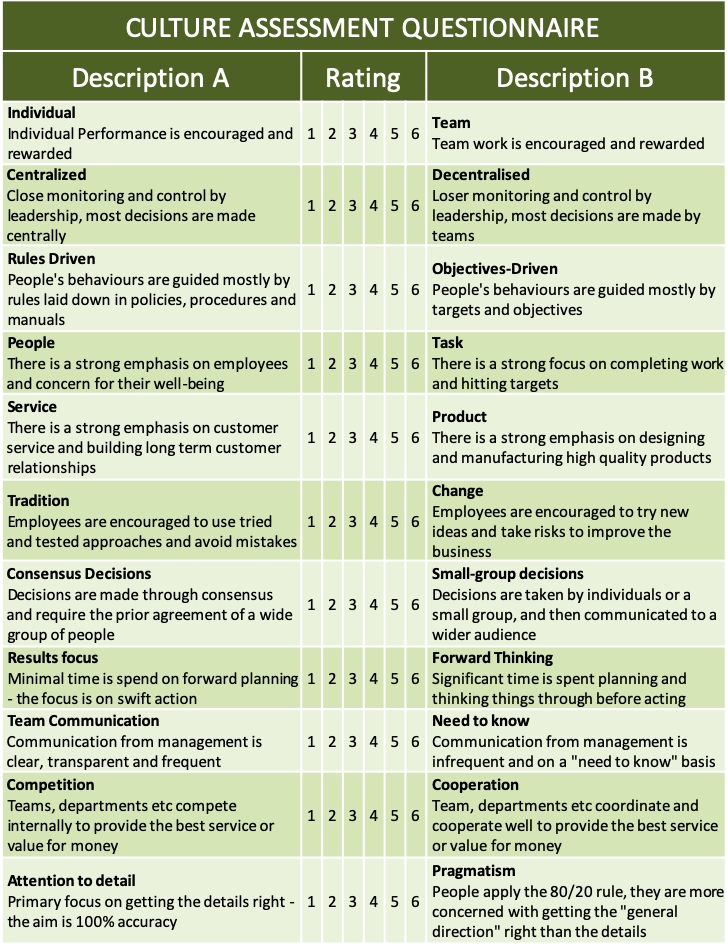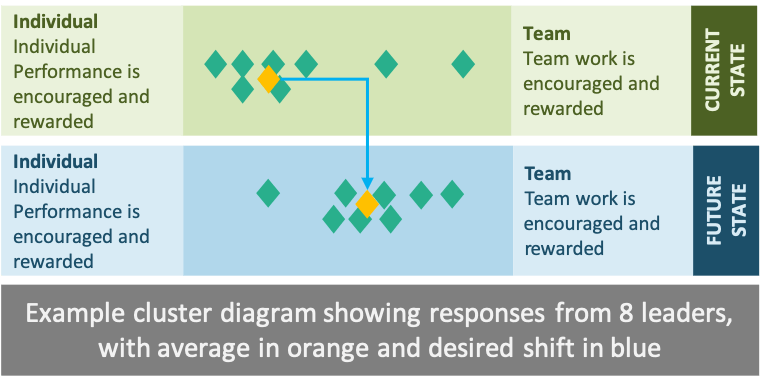Key Learning Points: This simple organizational culture assessment questionnaire helps leadership teams assess culture. It helps them understand both what their current culture is like, and what they would like it to be like.
Organization Culture Assessment
There are many different examples of “cultural assessment” questionnaires that are used in different industries and for different purposes. Ultimately, they all aim to help teams learn about their organizational cultures. They all do roughly the same three things:
- Give people the language to speak effectively about culture,
- Capture a summary of the current working culture in the team, and
- Document what the team would like their culture to be like.
There are no right or wrong answers in most culture assessments, just different ways to do things. While culture assessments are very useful, they only explore a current state and a desired future state. Teams still need to develop the steps needed to move between the two.
A Simple Organization Culture Assessment Questionnaire
This specific cultural assessment questionnaire is useful for teams or organizations that are going through change. It’s particularly useful when a new leadership team is formed or when existing leadership teams are combined. This activity helps a group of leaders understand how they each think about the cultures within their teams, and helps them reach an understanding on what they would collectively like their future culture to be.
To complete this activity, circulate the questionnaire below (or a similar questionnaire of your own design) to your leaders and ask them each to fill it in twice, once for how they think the culture currently is and once for how they think it should be.

Once you’ve gathered your responses, consolidate them into two diagrams, one for the current state and one for the future. In each diagram, plot each leader’s position anonymously on a sliding scale between the two paired descriptions. Also plot an average for both the current state and the desired future state.
Once you’ve completed this plotting, you’ll have a cluster diagram for each culture pairing. This diagram will make it easy for the leadership team to understand their current levels of alignment, and where they desire to change their culture.

Next steps
Once you’ve analyzed your simple organizational culture assessment questionnaires and produced your outputs, the next step is to share the outcomes with your leaders in a facilitated workshop.
You should use the workshop to let leaders communicate their views, express their opinions, use their own language around both the current and future state and to try and build consensus over what they would like the organization to be like.
Once you’ve gained some consensus and agreement over what the desired culture is for the organization, you should facilitate a conversation focused on identifying activities or changes that can be undertaken to move the organization towards the desired culture.
Learning More
We’ve also written briefly on the Denison culture survey as well as the organizational culture triangle, fearless feedback, crabs in buckets and different types of organizational cultures.
Most organizations seek to improve their cultures through Organizational Development Programs. They do this because they know that good cultures lead to good employee experience, and to good employee engagement. Unfortunately some organizations opt for culture washing as opposed to actually improving their cultures.
Our View
Culture is a funny thing. It’s subjective, a bit “fluffy”, hard to measure, hard to change and yet is perhaps the most important factor in an organization’s success. Unfortunately, many leaders don’t feel they have the time to spend working on culture, and some leaders are slightly intimidated but the concept of it, so you may need to work hard to engage them.
As with many tools of this type, the specifics of what is included in this simple organizational culture assessment questionnaire may not be as important as the conversations that it can lead to. Given this, you may wish to change the questions to fit your specific needs. You might also wish to modify them to use any common language that exists in your organization.
When you’re working with leaders on activities like this, it’s important to ensure you focus on helpful, forward looking activities, not backwards looking blame based conversations.
Our one large criticism of approaching culture in this way is that it’s top down. While there are advantages to this, we think that it’s actually very important to listen to the wider organization about what an effective culture is. We believe that culture change related activities should be co-created with everyone in the organization, as much as possible. Given this, we would suggest that this activity should be undertaken in conjunction with a wider conversation with employees at all levels of the organization.
How We Help Organizations
We provide leadership development programmes and consulting services to clients around the world to help them become high performing organizations that are great places to work. We receive great feedback, build meaningful and lasting relationships and provide reduced cost services where price is a barrier.
Learning more about who we are and what we do it easy: To hear from us, please join our mailing list. To ask about how we can help you or your organization, please contact us. To explore topics we care about, listen to our podcast. To attend a free seminar, please check out our eventbrite page.
We’re also considering creating a community for people interested in improving the world of work. If you’d like to be part of it, please contact us.
Sources and Feedback
This post is based on our experiences delivering culture change activities in the world of work. There are no specific references for it. If you are aware of anyone that this content or concept should be attributed, please let us know.
We’re a small organization who know we make mistakes and want to improve them. Please contact us with any feedback you have on this post. We’ll usually reply within 72 hours.






